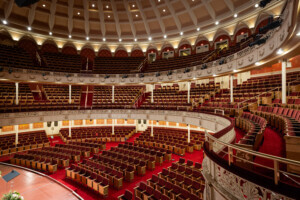What has been described as a “groovy sea beast” and a “kind of happy dinosaur with an elongated neck” painted by the late New York City pop artist and social activist Keith Haring on the side of a museum storage warehouse at Amsterdam’s Central Market Hall in 1986 will at long last undergo restoration work after being unearthed in June 2018. When the building was turned into a cold storage facility in 1989, Haring’s 40-foot-tall mural—his largest surviving one in Europe—was completely covered by insulating aluminum weatherboarding. Now, if all goes as planned, the mural will be carefully restored later this year.
Restoration work, headed in part by the Stedelijk Museum in an advisory role, was initially slated to commence this past April. That plan, however, was put on hold due to the coronavirus pandemic. As reported by the Art Newspaper, the long-awaited restoration project, with a price tag of roughly $202,000, can finally begin as travel restrictions across Europe start to ease.
At the end of last year, the Stedelijk Museum announced that an international team headed by independent art conservators, U.S.-based Will Shank and Italy-based Antonio Rava, who have together restored other murals completed by Haring in Paris and Pisa, will handle the restoration. The Keith Haring Foundation, the municipality of Amsterdam, and developer Marktkwartier are funding the undertaking, which is expected to take roughly a month to a month-and-a-half to complete.
As noted by the New York Times in 2018, the mural—a single-line monochrome creation depicting a mythical human-armed dog-fish mounted by one of Haring’s characteristic x-marked humanoid figures—was painted onto a brick wall of the building in a single day. Haring was in Amsterdam at the time celebrating the launch of his 1986 solo exhibition at the Stedelijk Museum, the largest museum dedicated to modern and contemporary art in the Netherlands, and asked the museum curators if he could also create a public work outside. He was offered the wall at a museum storage depot on the grounds of a sprawling wholesale market in the western section of the city. With a crucial assist from a crane, he soon got to work.

It wasn’t until 2017 when Haring’s 1986 work at the Stedelijk Museum, a massive kaleidoscopic canopy titled Keith Haring Velum, was extensively restored and went back on view that widespread interest began to grow in his “forgotten” mural at the Central Market. (Haring passed away in February 1990 at the age of 31 of AIDS-related complications.)
“You can’t imagine when the first pieces of cladding came off, and you see the first stripes of Haring’s painting appear,” famed Dutch graffiti artist Aileen Middel (a.k.a. Mick La Rock) told the Times of the mural’s reveal after nearly 30 years of being obscured. “Hey, we have a Haring!”
Middel was instrumental in drawing public attention to the cladding-covered mural and initiated a public campaign to have the insulating panels removed so that, eventually, it could be properly restored.
As for the upcoming restoration, the Art Newspaper reported that the mural itself is in relatively good shape due to the fact that it’s been shielded from the elements since 1989. There is, however, some paint loss. Shank explained that the fact that the mural was drawn on two different types of brick will make the restoration challenging, but not impossible. Shank also told the Art Newspaper that the type of white paint used by Haring, an oil-based alkyd paint, “doesn’t have a good track record for enduring outdoors.” Because of these factors, roughly 20 percent of the work will have to be inpainted.
A protective coating will be then applied to the restored mural, which Marktkwartier and the municipality of Amsterdam hope to showcase as a massive redevelopment scheme kicks off in the vicinity of the market.











